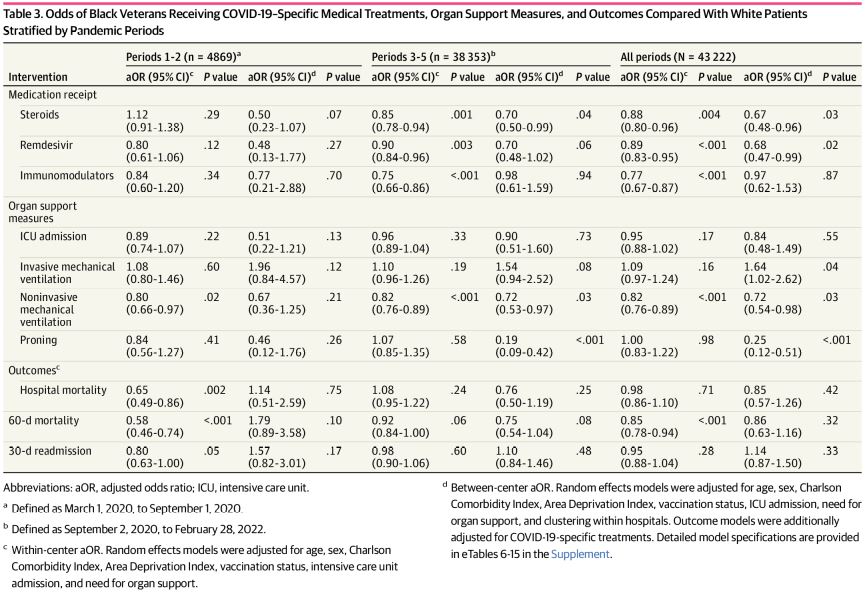Black Patients Received Different Interventions
PITTSBURGH — Black veteran patients received different medical interventions than white patients when hospitalized with COVID-19 in VAMCs across the country, according to a new study.
The study published in JAMA Network Open analyzed data on 43,222 adult veterans (28.1% Black) hospitalized with COVID-19 at 130 VAMCs between March 1, 2020, and Feb. 28, 2022.1
The researchers, who had access to the VA COVID-19 Shared Data Resource, said their findings suggest that, while treatment was different, there appeared to be little effect on outcomes.
“We found that after adjusting our comparisons for differences in patient baseline characteristics (such as age, the number of chronic health conditions, etc.) that Black veterans—among those who were hospitalized and required additional oxygen as part of their treatment—had slightly lower odds of being treated with steroids, antivirals (remdesivir) and immune-modulating drugs (tocilizumab or baracitinib) compared to white veterans,” corresponding author Florian Mayr, MD, MPH, a staff physician at the Pittsburgh, PA, VA Pittsburgh Healthcare System, told U.S. Medicine. “Encouragingly, we did not observe any differences in outcomes.”
Racial disparities in treatment have been reported across many different subspecialties in medicine and healthcare systems in the United States. For this study, the researchers cited a number of potential reasons for these disparities, including differential uptake and application of evolving knowledge (sometimes contradictory) throughout the pandemic and bias of some of the devices used in hospitals to monitor the respiratory status in patients with respiratory disease. For instance, pulse oximetry has recently been shown to work less reliably in patients with darker skin color, Mayr explained in an email.
In addition, he suggested that disparities might exist because of different patient preferences and acceptance of evolving treatments—which wasn’t accounted for in the study—and how physicians make decisions that may include unconscious biases, adding that interventions are needed to reduce these disparities.
“Our analyses showed that differences existed within and between hospitals,” Mayr wrote in an email. “So interventions would have to target hospitals that performed ‘poorer’ than others. More study is necessary to understand better the factors driving within hospital differences. In my opinion, awareness is the first step toward change.”
Organizations such as U.S. News and World Report, which regularly publish hospital performance metrics, plan to include health equity measures soon. This may further incentivize healthcare organizations to improve the status quo, Mayr explained.2
“Overall, the VA provides excellent health care,” Mayr wrote in an email. “Racial disparities in COVID care are not unique to VA, but have been shown across many different health care systems in the U.S. Encouragingly, we did not observe any differences in veteran outcomes despite small differences in treatment. We take pride in providing care to all veterans regardless of their race/ethnicity, sexual orientation, location, etc., and will continue to work hard to provide the most equitable care.”
In a statement, VA Press Secretary Terrence Hayes said, “As a matter of practice, we at VA routinely evaluate disparities in benefits and service delivery to ensure that all Veterans receive world-class care. And we need to do more. We appreciate the researchers who highlighted the disparities in care as outlined in the study published in the Journal of the American Medical Association (JAMA). We are committed to doing whatever it takes, from corrective action to building scalable and sustainable best practices, to address these concerns. All veterans, regardless of race, must be provided with the same high level of care; any disparity in care is unacceptable.”
“There is nothing more important to us than the health and safety of all the Veterans we serve, and we recognize that providing world-class care for veterans means providing equitable treatment across all racial and ethnic groups,” Hayes said in the statement. “We have instituted several actions to promote equitable care, including executing our Inclusivity Campaign to promote a welcoming environment, identifying and tracking any disparities in care, and addressing issues where we find them.”
These efforts have led to the VA outperforming the nation in vaccination of patients of color, as well as Black veterans having far better outcomes when brought to VA in emergencies compared to those brought to private sector hospitals, Hayes explained in the statement.3 In addition, Hayes noted a recent national Centers for Disease Control and Prevention (CDC) study that suggested greater disparities exist outside the VA—30% versus the 5-10% observed in the JAMA Network Open study.4
Still, Hayes acknowledges there is more work to do.
“We will continue to seek out, diagnose, and eliminate any disparities in care and—in doing so—hold ourselves accountable to delivering equitable care for all veterans,” Hayes said in the statement.
- Castro AD, Mayr FB, Talisa VB, Shaikh OS, Omer SB, Yende S, Butt AA. Variation in Clinical Treatment and Outcomes by Race Among US Veterans Hospitalized With COVID-19. JAMA Netw Open. 2022 Oct 3;5(10):e2238507. doi: 10.1001/jamanetworkopen.2022.38507. PMID: 36282499; PMCID: PMC9597393.
- Binger T, Chen H, Harder B. Hospital Rankings and Health Equity. JAMA. 2022 Nov 8;328(18):1805-1806. doi: 10.1001/jama.2022.19001. PMID: 36251309.
- Chan DC, Danesh K, Costantini S, Card D, Taylor L, Studdert DM. Mortality among US veterans after emergency visits to Veterans Affairs and other hospitals: retrospective cohort study. BMJ. 2022 Feb 16;376:e068099. doi: 10.1136/bmj-2021-068099. PMID: 35173019; PMCID: PMC8848127.
- Boehmer TK, Koumans EH, Skillen EL, et al. Racial and Ethnic Disparities in Outpatient Treatment of COVID-19 ― United States, January-July 2022. MMWR Morb Mortal Wkly Rep 2022;71:1359-1365. DOI: http://dx.doi.org/10.15585/mmwr.mm7143a2.



